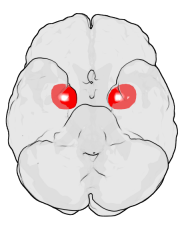
Photo from wikipedia
INTRODUCTION Social anxiety disorder (SAD) has been characterized by deficits in social motivation and lack of reactivity to pleasurable stimuli (i.e., positive affect; [PA]). Recent neuroimaging work has shifted toward… Click to show full abstract
INTRODUCTION Social anxiety disorder (SAD) has been characterized by deficits in social motivation and lack of reactivity to pleasurable stimuli (i.e., positive affect; [PA]). Recent neuroimaging work has shifted toward examining positively valenced motivational systems in SAD focused on reward responses. However, little is known about the associations of reward connectivity and PA in individuals with SAD. As such, the purpose of the current study was to determine whether connectivity among key units of reward neurocircuitry meaningfully relate to PA and whether these key units are more heterogeneous in SAD as compared to controls. METHODS Thirty-one participants who met diagnostic criteria for SAD and 33 control participants were included (Mage = 24.8, SD = 6.9; 55% cisgender man). Seed-based timeseries correlations were conducted in NiTime to extract region of interest (ROI) coupling correlation strength values. ANOVAs were carried out to assess whether individuals with SAD differed in ROI-to-ROI connectivity strength as compared to controls. Correlations and variance analyses were also conducted to examine the relationship between ROI-to-ROI connectivity strength and PA, as well as heterogeneity in connectivity strength and PA expression. RESULTS Weaker connectivity between the left and right orbital frontal cortex was observed when comparing the SAD to the control group. Within the SAD group, PA was associated with several reward-related ROI couplings; however, these links were not observed among controls. Results further demonstrated that individuals with SAD had significantly more variability in reward connectivity strength as compared to controls. CONCLUSION Overall, these results provide emergent evidence for the association between reward regions and PA in individuals with SAD. Additionally, these findings show that individuals with SAD demonstrate greater heterogeneity in reward connectivity.
Journal Title: Brain and behavior
Year Published: 2023
Link to full text (if available)
Share on Social Media: Sign Up to like & get
recommendations!